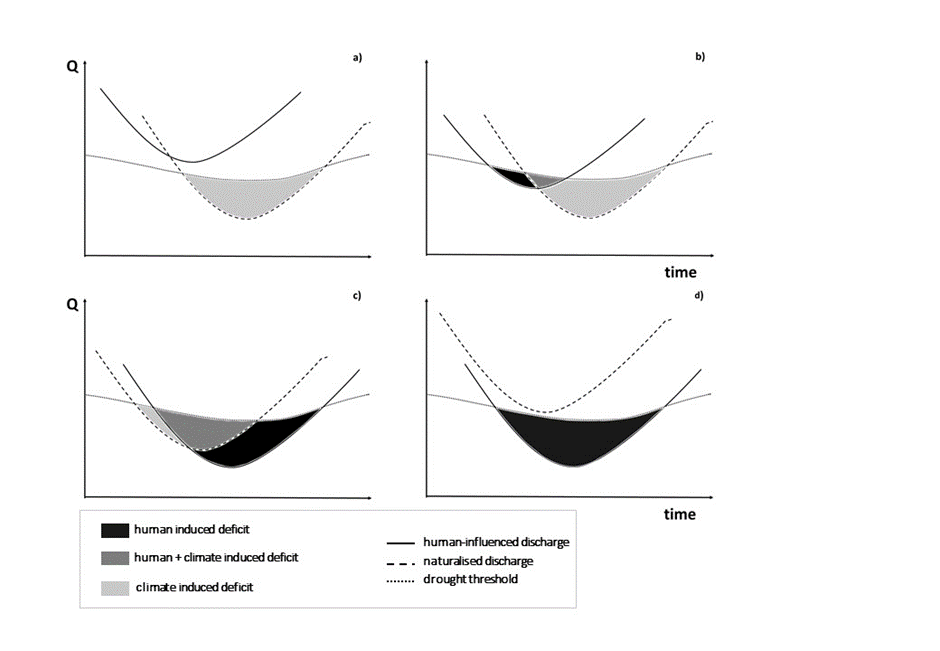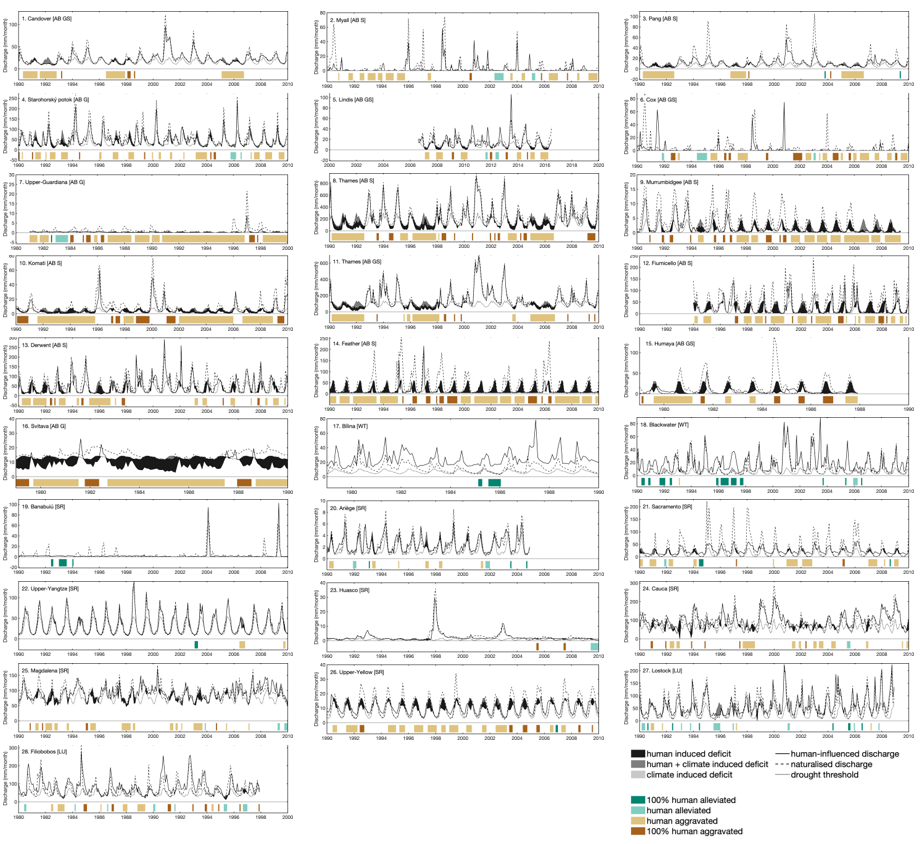New paper from our group!
“Streamflow droughts aggravated by human activities despite management” in ERL
https://iopscience.iop.org/article/10.1088/1748-9326/ac5def
We investigated the influence of human activities on streamflow drought in the complexity of real world cases, using observation data, qualitative expert assessment, consistent drought analysis, and statistics.
We found that groundwater and surface water abstractions aggravate streamflow droughts (between +20% and +305% for total time in drought, and up to +3000% for total deficit), water inflows alleviate them (up to -97% for total time and total deficit), and reservoirs both aggravate and alleviate (-26 to +38% for average duration and -86 to +369% for average deficit). Land use change had a smaller impact, with both increases and decreases (−48 to +98%).

We also saw that in cases with water abstraction almost all drought events were aggravated, also when there was water management that explicitly aimed to reduce streamflow droughts. This only helped during extreme low flow events, but not during other relatively dry periods.
For water storage and release cases (reservoirs), this was different. Reservoirs change the seasonality of flow and therefore cause both aggravation and alleviation of streamflow drought downstream. Also the reservoirs that release water for downstream use had slightly more alleviated droughts compared to those that did not explicitly release for downstream.

The statistical analysis showed that:
- abstraction cases with water transfer / downstream water use did NOT show a significant difference in human influence on drought compared to cases without water inputs;
- reservoirs that released water for downstream water use (for agriculture, flood control, public water supply) still mainly showed aggravation of drought;
- urbanisation effects on streamflow drought are potentially compensated by sewage return flows, pipe leakage & other human inflows.
And also that:
- there was no statistical relation between human influence on drought and the number of purposes, suggesting that multi-purpose reservoirs do not have more influence on streamflow drought;
- there was no relation with purpose of the abstracted water (agriculture, drinking water supply, energy production, etc.) or source of abstraction (groundwater and/or surface water);
- overall effect of human activities on streamflow droughts is independent of catchment characteristics or climate region (not more influence in drier regions);
- only amount of abstraction (estimate of the ratio of abstraction to mean annual flow) could explain the differences in influence on drought characteristics;
- effects of land use change are hard to untangle, because in urbanized or agricultural catchments many other human activities take place and the land use effects cannot be isolated with data-based methods in case studies.
We based this conclusions on the analysis of 28 empirical cases, collected as a group effort by the IAHS Panta Rhei ‘Drought in the Anthropocene’ group. With these case studies we can investigate the complexity of real world cases and include qualitative expert knowledge of the human-water interactions in the area. This could be very useful information for model studies that have to rely on patchy data and uncertain assumptions about human-water interactions.

We did this in a combination of re-analysis of existing cases and analysis of new cases, because it was impossible to compare results from published literature. In the table below you see the diversity in methodologies and choices made in the drought analysis and reporting of results. Studies used standardised indices or threshold methods, they used a different level to define droughts, and they used a different reference in the calculations (f.e. was the reference recalculated for the human-influenced time series or not, see how this underestimates the human influence on drought in this paper by Sally Rangecroft). Most studies only analysed a single case or a limited number of cases (2, 3 or 6). And studies that do a comparison between cases are always done in the same region with relatively similar climate and catchment characteristics and human activities. We wanted to analyse more cases and also with more diversity in region and activities.


Therefore, we used a consistent methodology to define drought with an 80th percentile monthly threshold on human-influenced and benchmark streamflow timeseries. The benchmark timeseries were obtained with one of three approaches: paired-catchment, upstream-downstream, and naturalized-observed. Then classified into human drought types: (a) 100% human-alleviated drought (i.e. prevented drought); (b) human-alleviated drought; (c) human-aggravated drought; and (d) 100% human-aggravated drought (i.e. human-induced drought).

We see this paper as an important first step in global-scale comparison of observation-based cases on the human influence on streamflow drought. This collection of cases will be included as IAHS Panta Rhei benchmark dataset. The data are available here.
This paper was very much a group effort! This is the list of collaborators and co-authors: Sally Rangecroft, Gemma Coxon, Micha Werner, Niko Wanders, Giuliano Di Baldassarre, Erik Tijdeman, Marianne Bosman, Tom Gleeson, Alexandra Nauditt, Amir Aghakouchak, Jose Agustin Breña-Naranjo, Omar Cenobio-Cruz, Alexandre Cunha Costa, Miriam Fendekova, Graham Jewitt, Daniel Kingston, Jessie Loft, Sarah Mager, Iman Mallakpour, Ilyas Masih, Héctor Maureira-Cortés, Elena Toth, Pieter Van Oel, Floris Van Ogtrop, Koen Verbist, Jean-Philippe Vidal, Li Wen, Meixiu Yu, Xing Yuan, Miao Zhang and Henny Van Lanen
The process started many years ago at AGU 2014 with Henny Van Lanen, brainstorming about a student project. Then Sally joined the new research team @ Birmingham in 2015. Then, in 2016, our first Panta Rhei Drought in the Anthropocene workshop in Birmingham. Then many years of data collection and analysis, many discussions at EGU conferences. Then (in between several job switches of the core team & two years of pandemic) many iterations of text and figures. Then one rejection and many major revisions. But finally the paper is there. What a journey!


You must be logged in to post a comment.